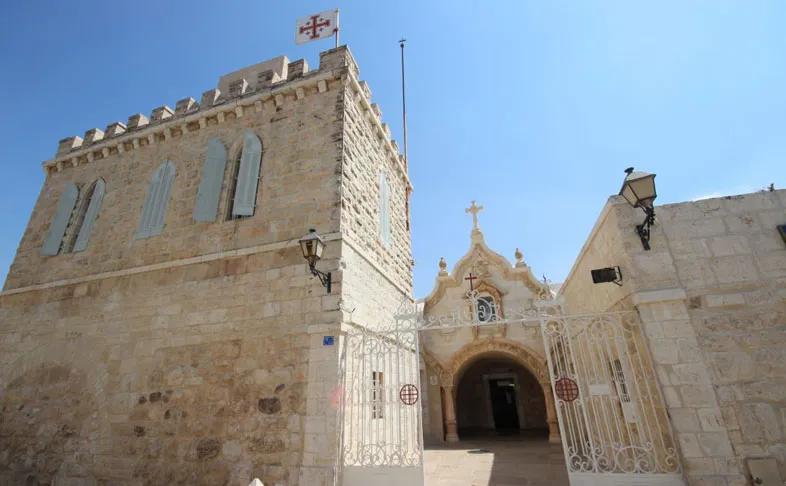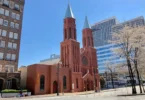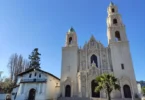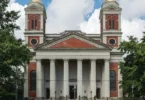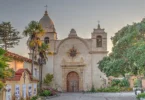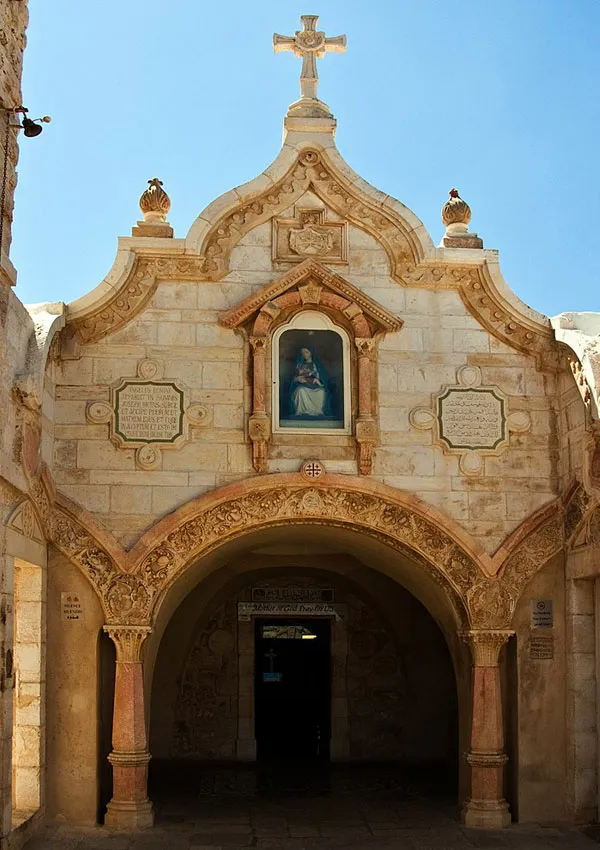
Introduction
The Chapel of the Milk Grotto of Our Lady, Bethlehem (Latin: Crypta lactea; Arabic: مغارةآلسثئ; Hebrew: מערת החלב) also called Grotto of Our Lady or Milk Grotto, is a Catholic chapel in Bethlehem in the West Bank of the Palestinian Territories, erected in 1872. Since Byzantine times, the place has been a center of Christian pilgrimage, maintained since its last erection together with its Marian shrine and monastery by the Custody of the Holy Land of the Order of the Friars Minor of the Catholic Church in Palestine. The Status Quo, a 250-year-old understanding between religious communities, applies to the site.
Chapel of the Milk Grotto of Our Lady, Bethlehem – The current Catholic chapel was built in 1872 on the site of a former Byzantine church from around the 5th century, of which only part of the mosaic floor remains.
Christian tradition says is the place where the Holy Family found refuge during the Massacre of the Innocents, before they could flee to Egypt. The name is derived from the story that a “drop of milk” of the Virgin Mary fell on the floor of the cave and changed its colour to white.
The space, which contains three different caves, is visited by some in hope of healing infertile couples, the shrine allegedly being a place where prayers for children are miraculously answered. The Milk Grotto is said to be the place where the Holy Family found their refuge during the Massacre of the Innocents, before they could flee into Egypt.
The Grotto’s name comes from the belief that a drop of the Virgin Mary’s milk fell down onto the floor of the cave and changed its color to milky-white. For ages, childless woman of many religions have visited the Milk Grotto in order to ask for the gift of offspring. They usually take with them a piece of the Grotto’s white rock that is believed to have magical power.
A Byzantine Church was built over the Grotto in the 5th century. Remnants of a colorful mosaic floor from that time can be seen in the courtyard of the present chapel, which was constructed around the Grotto by the Franciscan Brothers in 1872. The flat sculpture decorating the Chapel’s facade since 1935 is a fine example of local craftsmanship.
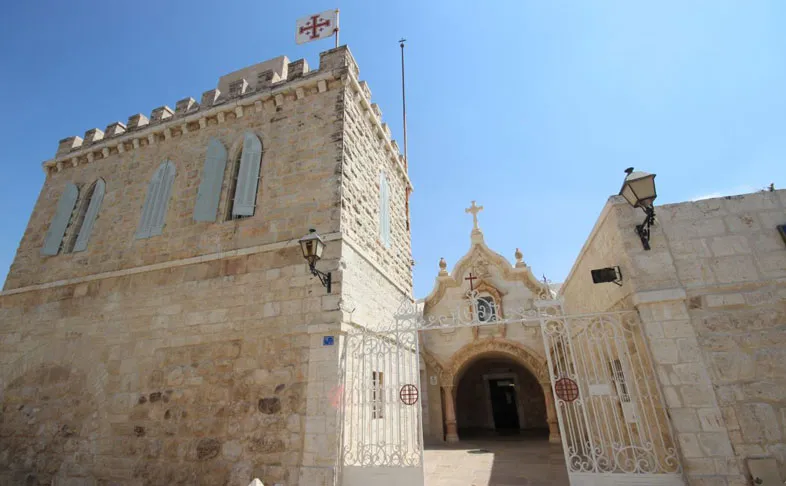
Monastery of the Perpetual Adoration of the Blessed Sacrament
The Chapel of the Milk Grotto of Our Lady, Bethlehem – A monastery of the Sisters of Perpetual Adoration of the Blessed Sacrament is attached to the chapel. The red-and-white clad nuns practice perpetual Eucharistic adoration, and are also uninterruptedly praying for peace since 2016, when a ‘Queen of Peace’ tabernacle was installed in their Eucharistic Adoration Chapel.
The tabernacle was donated by the Polish community ‘Queen of Peace’ to the Franciscan Custody of the Holy Land. It was originally designed for the Fourth Station of the Via Dolorosa in Jerusalem, but was eventually moved to the Sisters of Perpetual Adoration at the Milk Grotto in 2016, because they were better prepared to ensure the continuous prayer for peace.
The Polish artist who designed the tabernacle, Mariusz Drapikowski, explains his work as inspired by the Apocalypse of St John: the closed tabernacle depicts earthly Jerusalem, with the twelve Apostles and the twelve Tribes of Israel surrounding the image of Jesus on the cross, while the open shrine is representing the heavenly Jerusalem, brightly shining and flanked by a pair of olive trees which symbolise the two witnesses of the Apocalipse.
Their branches are filled with a variety of different crosses, symbolising the various Christian professions emerging from the common trunk of Christianity. At the centre of the open shrine stands the monstrance showing a Madonna holding in her hands the Eucharistic Christ, depicted as a large host.
Our Lady of Milk Grotto

The Chapel of the Milk Grotto of Our Lady, Bethlehem – A short distance south of the Church of the Nativity in Bethlehem is a shrine called the Milk Grotto, on a street of the same name.
An irregular grotto hollowed out of soft white rock, the site is sacred to Christian and Muslim pilgrims alike. It is especially frequented by new mothers and women who are trying to conceive.
By mixing the soft white chalk with their food, and praying to Our Lady of the Milk, they believe it will increase the quantity of their milk or enable them to become pregnant.
Rows of framed letters and baby pictures sent from around the world to the Milk Grotto testify to the effectiveness of the “milk powder” and prayer. (The powder is available only at the shrine; it may not be ordered from overseas.)
The Milk Grotto is considered sacred because the Holy Family took refuge there before their flight into Egypt to escape King Herod’s slaughter of the innocent firstborns. It is said that while Mary was nursing Jesus, a drop of milk fell to the ground, turning the cave white. Stories abound from the Grotto in the Holy Land, and the shrine in St. Augustine, about children born to parents who had struggled for years to conceive or had been told there was no hope.
To this day the Franciscan community maintains a shrine there called the Milk Grotto. Its center piece is the Blessed Virgin nursing the infant Jesus. Many ask for the blessings of motherhood, beseeching the intercession of Our Lady that God will grant them a safe and happy delivery, and healthy, holy children. All who visit the Shrine find it to be a place of spiritual comfort and renewal.
Husbands and wives are asked to pray together the third of the joyful mysteries of the rosary, meditating on the birth of the Lord Jesus. Whether your prayers for fertility involve you, or a family member or friend, prayer must always be a component of your quest.
Lovely Lady of the Milk, most loving Mother of Jesus, and my mother, listen to my humble prayer. Your motherly heart knows my every wish, my every need. To you only, his spotless Virgin Mother, has your Divine Son given to understand the sentiments which fill my soul. Yours was the sacred privilege of being the Mother of the Savior. Intercede with him now, my loving mother, that in accordance with his will (your request here). This I ask, O Lady of the Milk, in the name of your Divine Son, my Lord and Savior. Amen.
O Mary conceived without sin, pray for us who have recourse to you. Our Lady of the Milk, pray for us.
History of Our Lady of Milk Grotto
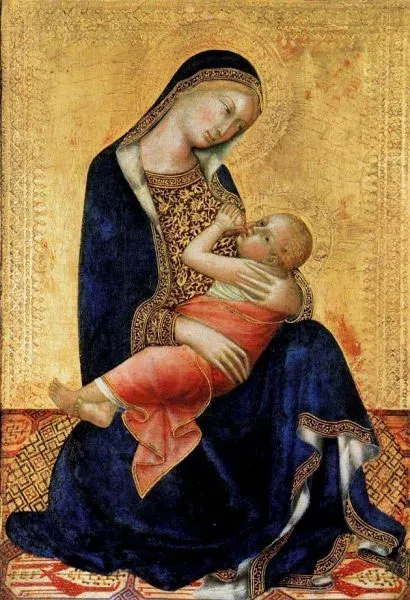
The Chapel of the Milk Grotto of Our Lady, Bethlehem – The rows of framed letters and baby pictures are testimony that the Milk Grotto – where Mary is said to have nursed Jesus as the Holy Family fled to Egypt – has been much more than a pilgrimage to many couples.
One picture on the wall of the Milk Grotto’s chapel shows a mother from Argentina happily nursing her new-born baby. In another letter a mother from Spain wrote, “Carmen is a gift from heaven.” A couple from Ireland wrote, “In thanksgiving and deep gratitude to Our Blessed Lady for our dear son Jamie.”
Another mother from India described how she and her husband had given up on a child after nine years of trying to conceive. Now, she wrote, after the birth of their daughter, her “whole life will be a life of thanksgiving.” From Venezuela another woman wrote how after five miscarriages she gave birth to a “miracle baby, Leonardo Jose.”
One after another, parents from such far-flung places as Sri Lanka, the United States, Canada, Bermuda and England have written about the miraculous birth of their children after having prayed using the “milk powder” from the grotto.
The Chapel of the Milk Grotto of Our Lady, Bethlehem – “Throughout the centuries this has been a place for special devotion for women … who are trying to conceive,” said Franciscan Brother Lawrence, an American who oversees the grotto and chapel for the Franciscan Custody of the Holy Land. According to tradition, he said, a few drops of Mary’s milk dropped onto the cave floor as she stopped to nurse her child.
“Women who can’t have children have a very hard time. With this prayer they are filled,” he said. Some people have even brought their babies back to the small shrine inside the grotto to give thanks, he said. The grotto is at least 2,000 years old and the early Christians came to pray here, he said, but the first structure was built over it around 385.
The faithful have venerated the spot for its powers as early as the fourth century, he said, and local women of all faiths and denominations come here to pray for children, taking with them bits of the “milk powder” from the soft limestone found throughout the grotto.
Holes the width of a finger can be found in several spots in the grotto ceiling of the newly renovated shrine, where over the years people have scraped out the fine dust to take home with them.
About 10 years ago when Brother Lawrence came to the grotto the Franciscans began preparing small packets of the limestone powder to give people for a small donation. They do not sell the powder online, he said, because the number of requests would be overwhelming and expensive to fill. Plenty of limestone to last for years is in blocked-off places in the grotto, said Brother Lawrence.
Sometimes friends and relatives of a couple trying to conceive have visited the shrine and take back the powder with them, and people have written attesting to the powder’s power to heal illnesses and reverse breach babies, he said.
The renovations on the shrine, which were started three years ago and completed at the end of 2006, have revealed sixth- and seventh-century Byzantine mosaic floors. The walls and ceiling were cleaned of soot from centuries of oil lamps and candle-burning. The structure was made handicapped-accessible, and a larger chapel was added on the second level to accommodate pilgrim groups who want to celebrate Mass there. A local Mass is held every Wednesday afternoon in the small church adjacent to the grotto.
The Sacramentine Nuns hold a round-the-clock prayer vigil in shifts at a special altar behind a glass window in a cordoned-off part of the shrine.
Faithful of all religions and denominations continue to venerate the grotto, said Brother Lawrence. Every denomination has a different form of prayer with the powder, he said, but according to Catholic tradition both the husband and wife must drink a bit of the powder mixed with milk or water for nine days and recite the prayer for the third joyful mystery of the rosary, said Brother Lawrence.
“They pray from their heart asking Our Lady of the Milk for intercession in healing,” he said, noting that he has heard of 1,700 babies born in the last 10 years and has read every one of the 400 letters that have been sent to the shrine, including 60 in the last six months. “The joy is immense,” he said. “When you have faith you can move mountains.”
Brother Lawrence said he knows there are people who are skeptical about the powers of such holy relics, and the powder’s mystery probably will not work on those who do not have faith. “Faith is a gift from God,” he said. “We who have been baptized have to be open to the Spirit. We need for our faith to be alive and that will enrich us.”
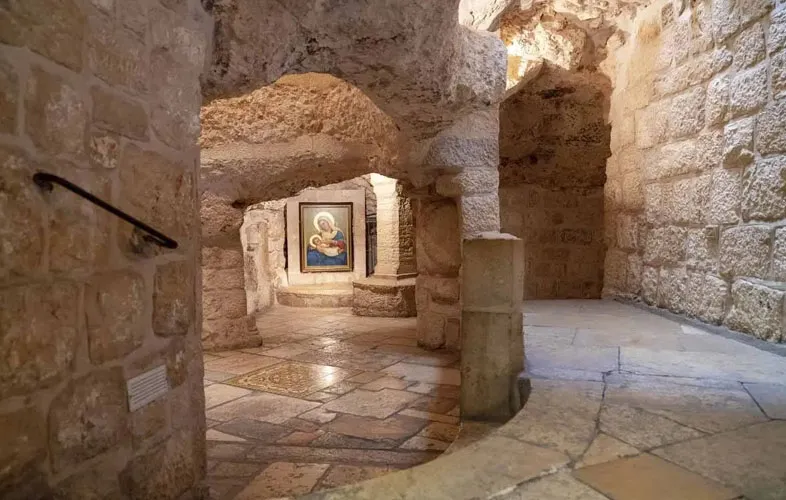
Spilt Milk turned Stone White, Tradition says
The Chapel of the Milk Grotto of Our Lady, Bethlehem – According to tradition, while Mary and Joseph were fleeing Herod’s soldiers on their way to Egypt, they stopped in this cave while Mary nursed the baby Jesus. A drop of Mary’s milk fell upon the stone and it turned white.
The grotto has been a site of veneration since the 4th century, the first structure being built over it around AD 385.
From as early as the 7th century, fragments from the cave were sent to churches in Europe. The site was recognised by a proclamation of Pope Gregory XI in 1375.
The Franciscans erected a church around the Milk Grotto in 1872. The people of Bethlehem and local artisans expressed their love for the site by decorating the shrine with mother-of-pearl carvings.
In 2007 a modern chapel dedicated to the Mother of God was opened. It is connected to the Milk Grotto church by a tunnel, which enabled the addition of a further chapel in the basement.
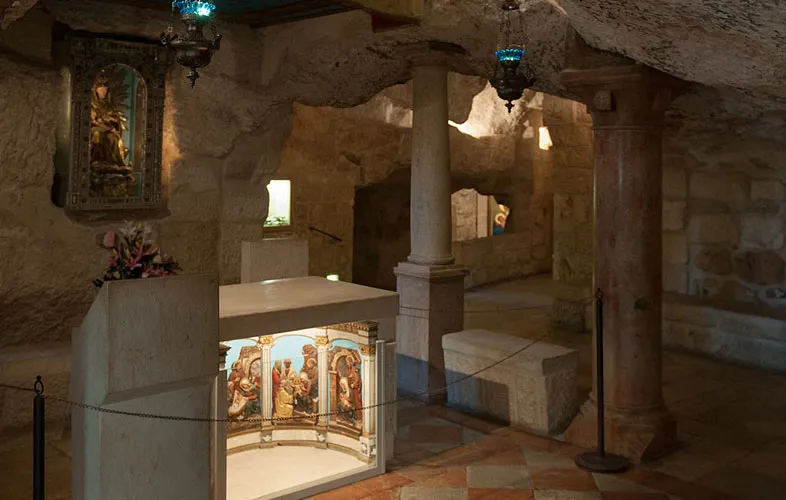
Feast Day - 2nd February
Annual Feast Day of Our Lady of Milk Grotto held on 2nd February.
Mass Time
Local Mass is held every Wednesday afternoon in the small church adjacent to the grotto.
Church Visiting Time
Every Days
- Summer (April – Sep) : 8:00 am to 12:00 (Noon) & 2:00 pm to 6:00 pm
- Winter (October – March) : 8:00 am to 12:00 (Noon) & 2:00 pm to 5:00 pm
Contact Info
Milk Grotto Street, Bethlehem,
West Bank of the Palestinian Territories.
Phone No.
Tel : +972 2 274 3867
Accommodations
How to reach the Chapel
Ben Gurion Airport is the main international airport of Israel is the nearby airport to the Chapel.
City Hall Light rail station in Jerusalem, Israel is the nearby airport to the Chapel.

